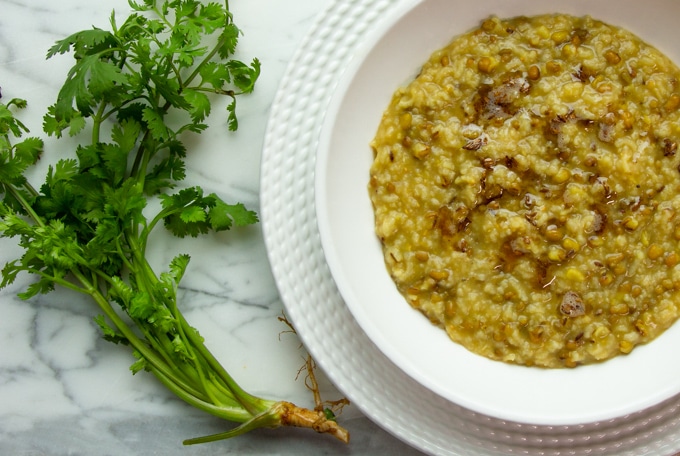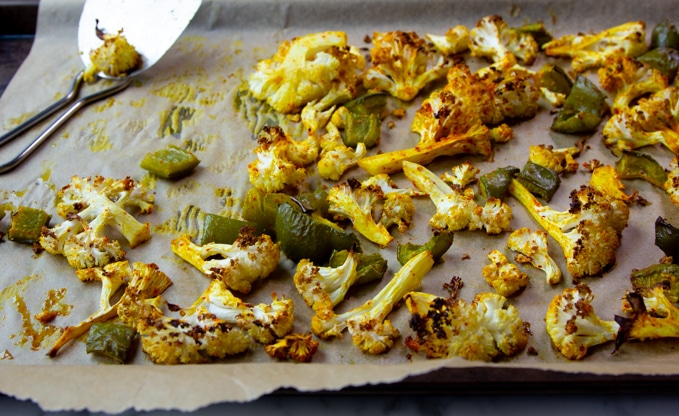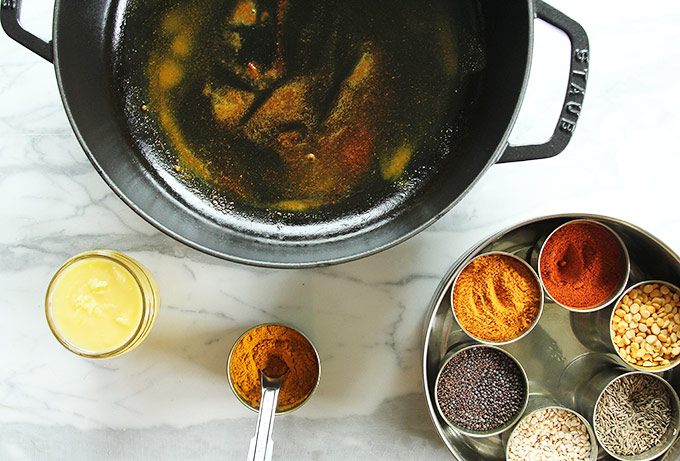This post may contain affiliate links. Please see our disclosure for more information.
The whole of India was in an uproar last year after the cabinet minister in charge of food processing suggested that khichdi be declared India’s national dish.
It happened during a charity event where celebrity chef and entrepreneur Sanjeev Kapoor cooked up 800 kilograms of khichdi to demonstrate India’s food processing prowess on the global stage.

To make matters more interesting, the feat resulted in a Guinness World Record for the largest khichdi, with it ultimately weighing in at 918 kilograms.
It took a 7-foot diameter wok-style pot to slow cook the soothing stew of basmati rice, mung beans, ghee, spices, and vegetables. Khichdi has been revered as a healing food in India since ancient times for its wonderful virtue of being extremely easy to digest.
The minister, Harsimrat Kaur Badal, started the brew haha after responding to a reporter’s simple question: Why did you pick khichdi?
Minister Badal’s reply was, “Khichdi is the wonder staple food of India, and is considered the healthiest prepared food in India, and it is being eaten across the length and breadth of India by rich and poor.”
The minister’s comment led to a robust debate in the world’s largest democracy about what dish deserved to be crowned India’s national dish.
Some people assumed khichdi was the national dish. But if this was true … wait? So many people wanted to know: why weren’t other popular foods like biryani chosen as the national dish instead?
In the midst of the online uproar, Badal took to Twitter to set the matter to rest … for the time being at least.
The fact of the matter is: There is no official national dish in India.

What Exactly Is Khichdi?
Khichdi is one of India’s most ancient foods. It makes perfect sense that the ancients embraced this dish. It is a complete vegetarian protein in a single pot that would have been cooked over an open hearth fire.
But this one pot meal is also incredibly delicious and satisfying, and there are endless variations of the dish.
The basic recipe consists of one part grain, one part bean, your choice of spices, optional vegetables, and a good amount of ghee, India’s special clarified butter.

Ghee itself is another one of those ancient healing foods.
The golden butter is pure butterfat, with the milk proteins removed so it is practically lactose free. And it has a heavenly nutty flavor that comes from caramelization of the milk proteins in the process of making ghee.
For a khichdi recipe, spices are heated in the ghee, which releases their flavor and aroma. The flavored ghee is then added to the very well-cooked rice and beans.
Vegetables are sometimes added for extra nutrition and variation.


Khichdis can be made with ingredients that target particular health conditions, as in the lung khichdi and spleen-pancreas khichdi recipes included in “The Ayurvedic Cookbook,” by Amadea Morningstar with Urmila Desai.
After ghee, the most common bean used for khichdi is another incredible food. That is the mung bean. In India they are sometimes called moong.
You can find the tiny, moss-colored bean in most grocery stores, since it is widely used throughout Asian cooking.

It also comes in split and hulled forms, but since those are less readily available, we are using the whole bean. However, a single bean is tiny at only a quarter inch in diameter.
Ancient Vedic Indian texts have referred to the mung bean as the “king of dal,” and that is saying a lot in a country that regularly makes use of dozens of different types of lentils and beans.
(Dal is another word for bean. It can also refer to the “curried” soup or stew dishes that are so characteristic of Indian cuisine.)
You can get my all-time favorite Indian dal recipe here. It is a simple whole mung dal recipe that is every bit as good as khichdi, but without the rice, so it’s gluten-free.
One of the Easiest Foods to Digest
India’s national dish aside, khichdi’s true claim to fame is how many ways people have spelled its name. Just kidding! But other spellings include khichadi, khichri, khichdee, khichuri, khichari, kitchari, and kitcheree.
To pronounce the word, it sounds like kitcheree. My husband insists I have the genuine and true Hindi transliteration, so I am going with khichdi.
Kidding aside, khichdi is great because it is one of the easiest meals in the world to digest. And a bowl of khichdi is a complete healthy meal.

Khichdi is the core of Ayurvedic nutritional healing. It is the sole food prescribed to individuals undergoing Panchakarma, which is a detoxifying program used in India’s traditional system of medicine, known as Ayurveda.
Panchakarma can last anywhere from days to weeks, so people eat khichdi for breakfast, lunch, and dinner, for this long, and they don’t feel deprived. Ohhhh … I have yet to try this, but I will one day for sure.
For those of you who know about China’s famous health food, congee, Khichdi is the Indian equivalent. (If you would like to learn more about congee, here is a good article written by a friend of mine.)
Both khichdi and congee are favored foods for children, the sick, the weak, and the elderly. It is that nourishing comfort food that makes you feel all warm inside.
About This Khichdi Recipe
Personally, I love eating khichdi regularly because it tastes so yummy, especially this recipe, which comes from my mother-in-law.
It is one of the dozen or so staples that she wrote down for my husband when he moved to the U.S. (Did he cook them? Not really, but lucky me. I have all of those precious recipes now.)
The taste of this khichdi is simply golden, with a nutty underlying flavor from ghee (about ghee) accented by crunchy toasted cumin seeds and superfood turmeric.

I don’t know if you have experienced the taste of caramelized rice? It isn’t that, but it tastes like it is.
I don’t know why I love it sooo much, but I suspect it has something to do with its wonderful digestibility. If the body doesn’t need to work hard to digest its food, there is more energy left for other things. That is how I look at it at least.
Khichdi is basically a one pot wonder. It fully satisfies. And it doesn’t take much time to make, as long as you remember to soak the rice and beans at least 4 hours ahead.
A Vegetable Topping Adds Texture And Flavor
A major innovation I added to this recipe is the optional vegetable topping. It requires another piece of cookware, but it is a very quick to cook up.
The vegetable topping is worth having because of the texture it adds to the meal. Of course, there is also the advantage of adding healthy vegetables filled with vitamins, minerals, and fiber.

Most recipes for khichdi that include vegetables involve cooking the vegetables together with the rice and beans. This means the vegetables become homogenous in the dish, with everything being very soft.
Indians love their food in a homogenous state, but Westerners tend to prefer their food separately, and I am a Westerner. This is why I love my khichdi with the vegetables on top.
The topping adds tremendous flavor from the vegetables, and the extra spices.


I have given it a light spicing of turmeric and black pepper, so the taste isn’t bland. Cauliflower and green peppers go really well with everything else in this dish.
By the way, you might be interested to know that cauliflower and peas are the most common vegetables added to khichdi.
I really hope you give this khichdi recipe a try. I would be so pleased for you experience the joys of khichdi. You just might find yourself craving it weekly. I think you’ll be thankful to have this recipe in your repertoire.
In the future, if India ever decides to put its national dish nominees to a vote, you’ll be able to cast your vote for khichdi!


Recipe for Khichdi With Cauliflower And Green Pepper
Equipment
- Pressure cooker
Ingredients
For the khichdi
- 1/2 cup rice
- 1/2 cup whole mung beans (or yellow moong dal)
- 4-5 cups water
- 1/2 teaspoon turmeric powder
- 1/2 teaspoon Himalayan pink salt or to taste
- 1/2 teaspoon ghee (to suppress foam when cooking beans)
For the khichdi seasoning (tadka)
- 1 tablespoon ghee
- 3/4 teaspoon cumin seeds
- pinch asafetida (optional, but recommended)
- 1 teaspoon ginger minced or grated
For garnish
- 1/2 lemon freshly squeezed
For the optional vegetable topping
- 1 teaspoon vegetable oil
- 6 cups cauliflower separated into florets
- 1 cup green pepper chopped
- 1/2 teaspoon turmeric powder
- pinch black pepper
- 1/2 teaspoon Himalayan pink salt
Instructions
- You can cook khichdi in a pressure cooker or a saucepan. In India, where this dish originates, it is always cooked in a pressure cooker. If you have a pressure cooker or Instant Pot, it will need to be at least 3 quarts in size. I have given the method for both the pressure cooker and saucepan. If you would like to learn more about cooking with a pressure cooker, see How to Cook Beans From Scratch.Soaking is always recommended when cooking dry beans, but it is optional for this recipe. Four hours is sufficient. After soaking, discard the water and rinse 3-4 times, until the water runs clear.
Make the khichdi
- To make khichdi in a pressure cooker: Place rice and mung beans in the pressure cooker with 4 cups of water, turmeric powder, salt, and half a teaspoon of ghee. INSTANT POT: Cover with the lid. Select “Pressure.” See that “High” is selected on the digital display. Set the timer for 10 minutes, and you can walk away. After the cooker is done, it will beep, and the timer will start counting up. Wait 15 minutes before you try to open the lid. Press the vent to release any residual steam, then remove the lid safely. STOVETOP PRESSURE COOKER: Cover with the lid. Place the pressure regulator onto the steam vent. Turn the heat to high and bring the cooker up to high pressure. Depending on your model, you will know you have reached high pressure when your gauge says 15 psi, or when your whistle goes off the first time. At this point, reduce the heat just enough to maintain high pressure. Set a timer for 6 minutes, then turn off the heat. Wait 15 minutes to allow the pressure to come down naturally before opening the lid.
- To make khichdi in a saucepan: Choose a saucepan with a thick bottom. Add rice, mung beans, 5 cups of water, turmeric powder, salt, and half a teaspoon of ghee. Cook for 40 minutes, or until the mung beans and rice get very soft and start to break apart.
For the khichdi seasoning
- Heat ghee in a small skillet on medium heat. Add cumin seeds and sauté until lightly browned. Add asafetida into the oil for about 20 seconds, then add the ginger. Sauté for 1-2 minutes, until the ginger starts to lightly brown, then turn off the heat.
- If you are making this khichdi without the vegetable topping, pour the hot spiced ghee onto the cooked rice and dal. Stir, taste, and adjust for salt. The dish is done. Serve into individual bowls and garnish with fresh lemon juice.
For the optional vegetable topping
- You can cook this vegetable topping in two ways based on your preference. Either sauté in a skillet on the stove, or roast on a sheet pan in the oven. Roasting is easier because once the vegetables are in, your oven does all the work. Skillet method: Heat vegetable oil in a large skillet on medium-high heat. Add turmeric and black pepper, and cook for a few seconds to release the flavor and aroma of the spices. Add cauliflower, green pepper, and salt, and mix well. Sauté, stirring occasionally, until vegetables are lightly browned (about 10 minutes). Roasting method: Preheat the oven to 400 degrees Fahrenheit. Add chopped vegetables to a large mixing bowl and add turmeric, black pepper, salt, and oil. Toss gently to mix. Arrange on a single layer on a baking sheet lined with parchment paper. Roast for 35 minutes, until the vegetables are caramelized on the edges.
To serve khichdi with the vegetable topping
- Portion khichdi into individual serving bowls and squeeze with fresh lemon. Top with spiced cauliflower and green peppers. Enjoy! This is a highly satisfying and complete vegetarian meal.
Notes
MAKE THIS VEGAN
Substitute ghee with coconut oil.Nutrition
I sincerely hope that you try my recipe, but if obtaining the ingredients is a challenge, I also recommend this kitchari kit from Pure Indian Foods in New Jersey.
It comes with 2 pounds of basmati rice and mung dal, a jar of ghee, and a kitchari spice mix. It is everything you need to make kitchari in about 25 minutes.
Going for this option can help get you started with this wonderful dish.
